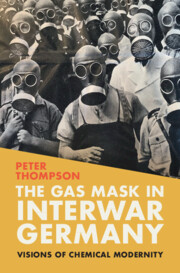Book contents
- The Gas Mask in Interwar Germany
- Science in History
- The Gas Mask in Interwar Germany
- Copyright page
- Dedication
- Contents
- Figures
- Tables
- Acknowledgments
- Abbreviations
- Introduction
- 1 The Structures of Violence: Fritz Haber and the Institutionalization of Gas Warfare
- 2 The Man in the Rubber Mask: World War I and the Development of the Modern Gas Mask
- 3 The First “Chemical Subjects”: Soldier Encounters with the Gas Mask in World War I
- 4 The Limits of Sympathy: The Medical Treatment of Poison Gas during and after World War I
- 5 Atmos(fears): The Poison Gas Debates in the Weimar Republic
- 6 Technologies of Fate: Cultural and Intellectual Prophesies of the Future Gas War
- 7 Synthesizing the “Nazi Chemical Subject”: Gas Masks, Personal Armoring, and Vestiary Discipline in the Third Reich
- 8 Prophets of Poison: Industrialized Murder in the Gas Chambers of the Holocaust
- Conclusion
- Bibliography
- Index
2 - The Man in the Rubber Mask: World War I and the Development of the Modern Gas Mask
Published online by Cambridge University Press: 11 May 2023
- The Gas Mask in Interwar Germany
- Science in History
- The Gas Mask in Interwar Germany
- Copyright page
- Dedication
- Contents
- Figures
- Tables
- Acknowledgments
- Abbreviations
- Introduction
- 1 The Structures of Violence: Fritz Haber and the Institutionalization of Gas Warfare
- 2 The Man in the Rubber Mask: World War I and the Development of the Modern Gas Mask
- 3 The First “Chemical Subjects”: Soldier Encounters with the Gas Mask in World War I
- 4 The Limits of Sympathy: The Medical Treatment of Poison Gas during and after World War I
- 5 Atmos(fears): The Poison Gas Debates in the Weimar Republic
- 6 Technologies of Fate: Cultural and Intellectual Prophesies of the Future Gas War
- 7 Synthesizing the “Nazi Chemical Subject”: Gas Masks, Personal Armoring, and Vestiary Discipline in the Third Reich
- 8 Prophets of Poison: Industrialized Murder in the Gas Chambers of the Holocaust
- Conclusion
- Bibliography
- Index
Summary
While the modern military gas mask was first designed by scientists such as Richard Willstätter in order to save German soldiers from chemical death, it ultimately contributed to the escalation of chemical warfare in World War I. New military tactics and advances in chemical weaponry such as gas shells and mustard gas were developed with the express purpose of “breaking the mask.” Thus, the gas mask was part and parcel of both the war of sheer material production and the chemical nightmare on the battlefield that helped precipitate the German defeat in 1918. By intertwining the historical development of gas with that of the gas mask, this chapter highlights moments in which a specifically German “chemical modernity” began to be conceptualized.
- Type
- Chapter
- Information
- The Gas Mask in Interwar GermanyVisions of Chemical Modernity, pp. 54 - 74Publisher: Cambridge University PressPrint publication year: 2023

